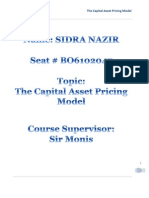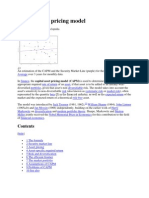Capital Asset Pricing Model - CAPM
Capital Asset Pricing Model - CAPM
Uploaded by
Sylvia ShirapovaCopyright:
Available Formats
Capital Asset Pricing Model - CAPM
Capital Asset Pricing Model - CAPM
Uploaded by
Sylvia ShirapovaOriginal Description:
Original Title
Copyright
Available Formats
Share this document
Did you find this document useful?
Is this content inappropriate?
Copyright:
Available Formats
Capital Asset Pricing Model - CAPM
Capital Asset Pricing Model - CAPM
Uploaded by
Sylvia ShirapovaCopyright:
Available Formats
What is the 'Capital Asset Pricing Model - CAPM'
The capital asset pricing model (CAPM) is a model that describes the
relationship between systematic risk and expected return for assets, particularly
stocks. CAPM is widely used throughout finance for the pricing of risky securities,
generating expected returns for assets given the risk of those assets and
calculating costs of capital.
BREAKING DOWN 'Capital Asset Pricing Model - CAPM'
The formula for calculating the expected return of an asset given its risk is as
follows:
The general idea behind CAPM is that investors need to be compensated in two
ways: time value of money and risk. The time value of money is represented by
the risk-free (rf) rate in the formula and compensates the investors for placing
money in any investment over a period of time. The risk-free rate is customarily
the yield on government bonds like U.S. Treasuries.
Find out which online brokers offer stock valuations in our new Brokerage
Review Center.
The other half of the CAPM formula represents risk and calculates the amount of
compensation the investor needs for taking on additional risk. This is calculated
by taking a risk measure (beta) that compares the returns of the asset to the
market over a period of time and to the market premium (Rm-rf): the return of the
market in excess of the risk-free rate. Beta reflects how risky an asset is
compared to overall market risk and is a function of the volatility of the asset and
the market as well as the correlation between the two. For stocks, the market is
usually represented as the S&P 500 but can be represented by more robust
indexes as well.
Read more: Capital Asset Pricing Model
(CAPM) http://www.investopedia.com/terms/c/capm.asp#ixzz4lGE6i7XJ
Follow us: Investopedia on Facebook
You might also like
- Capital Asset Pricing Model and Modern Portfolio TheoryDocument16 pagesCapital Asset Pricing Model and Modern Portfolio TheoryJemarie Mañgune SalacNo ratings yet
- Ameri TradeDocument7 pagesAmeri TradexenabNo ratings yet
- Definition of 'Capital Asset Pricing Model - CAPM'Document1 pageDefinition of 'Capital Asset Pricing Model - CAPM'Amit TripathiNo ratings yet
- Capital Asset Pricing ModelDocument1 pageCapital Asset Pricing ModelVinod MenonNo ratings yet
- Pim Mod-VDocument27 pagesPim Mod-VAkhand RanaNo ratings yet
- The Capital Asset Pricing ModelDocument5 pagesThe Capital Asset Pricing ModelFaisal KhanNo ratings yet
- Capital Asset Pricing ModelDocument8 pagesCapital Asset Pricing ModelJanani RaniNo ratings yet
- Capm + AptDocument10 pagesCapm + AptharoonkhanNo ratings yet
- RFR CapmDocument23 pagesRFR CapmAline Aprille Capuchino MendezNo ratings yet
- Capital Asset Pricing ModelDocument17 pagesCapital Asset Pricing ModelChrisna Joyce MisaNo ratings yet
- Assignment#04Document10 pagesAssignment#04irfanhaidersewagNo ratings yet
- Saim Unit 3 & Unit 4 NotesDocument9 pagesSaim Unit 3 & Unit 4 NotesSantosh MaheshwariNo ratings yet
- SHARPE SINGLE INDEX MODEL - HarryDocument12 pagesSHARPE SINGLE INDEX MODEL - HarryEguanuku Harry EfeNo ratings yet
- Capm-Apt Notes 2021Document4 pagesCapm-Apt Notes 2021hardik jainNo ratings yet
- Perf Assignment 1Document7 pagesPerf Assignment 1Blessed NyamaNo ratings yet
- Valuation of Securities Including Capital Asset ModelDocument11 pagesValuation of Securities Including Capital Asset Modelmayaverma123pNo ratings yet
- Capital Asset Pricing ModelDocument4 pagesCapital Asset Pricing ModelGeorge Ayesa Sembereka Jr.No ratings yet
- 2.3 Capital Asset Pricing Model ESPDocument11 pages2.3 Capital Asset Pricing Model ESPismaeleNo ratings yet
- Arbitrage Pricing Theory, CAPMDocument11 pagesArbitrage Pricing Theory, CAPMMazhar HossainNo ratings yet
- Capital Asset Pricing Model IIIDocument8 pagesCapital Asset Pricing Model III27usmanNo ratings yet
- Capital Asset Pricing ModelDocument8 pagesCapital Asset Pricing ModelashaarumugamNo ratings yet
- Capital Asset Pricing ModelDocument6 pagesCapital Asset Pricing ModelkelvinramosNo ratings yet
- Assignment of Security Analysis & Portfolio Management On Capital Asset Pricing ModelDocument6 pagesAssignment of Security Analysis & Portfolio Management On Capital Asset Pricing ModelShubhamNo ratings yet
- CMPMDocument8 pagesCMPMLarry DixonNo ratings yet
- Capm - FinalDocument13 pagesCapm - FinalPercy Lai Kong LingNo ratings yet
- Capital Asset Pricing ModelDocument10 pagesCapital Asset Pricing Modeljackie555No ratings yet
- Peace IbezimDocument7 pagesPeace IbezimPeace IbezimNo ratings yet
- Capital Asset Pricing ModelDocument8 pagesCapital Asset Pricing Modelمحمد حمزہ اسلمNo ratings yet
- Article Review Report On Revised Capital Assets Pricing Model An Improved Model For ForecastingDocument8 pagesArticle Review Report On Revised Capital Assets Pricing Model An Improved Model For ForecastingWorash EngidawNo ratings yet
- CAPM Represented in The SMLDocument3 pagesCAPM Represented in The SMLKarthik KNo ratings yet
- Portfolio Theories1Document17 pagesPortfolio Theories1ayazNo ratings yet
- What Does Capital Asset Pricing Model - CAPM Mean?Document6 pagesWhat Does Capital Asset Pricing Model - CAPM Mean?nagendraMBANo ratings yet
- Sapm Unit 3Document13 pagesSapm Unit 3pm2640047No ratings yet
- Capital Asset Pricing Model IntroductionDocument8 pagesCapital Asset Pricing Model IntroductionAshu158No ratings yet
- Lecture 28 PDFDocument13 pagesLecture 28 PDFAlson BenhuraNo ratings yet
- Capital Asset Pricing ModelDocument20 pagesCapital Asset Pricing ModelSattagouda M PatilNo ratings yet
- Capital Asset Pricing ModelDocument5 pagesCapital Asset Pricing ModelRajvi SampatNo ratings yet
- Equity Risk Premiums (ERP) : Determinants, Estimation and Implications - The 2012 EditionDocument107 pagesEquity Risk Premiums (ERP) : Determinants, Estimation and Implications - The 2012 EditionTuyết LongNo ratings yet
- Disadvantage 0f CAPMDocument4 pagesDisadvantage 0f CAPMromanaNo ratings yet
- On Capital Asset Pricing Model: Submitted byDocument14 pagesOn Capital Asset Pricing Model: Submitted bybansiiboyNo ratings yet
- An Analysis of CAPMDocument5 pagesAn Analysis of CAPMJenipher Carlos HosannaNo ratings yet
- Capital Asset Pricing Model - CAPMDocument5 pagesCapital Asset Pricing Model - CAPMGautam ReddyNo ratings yet
- What Is CAPM?: CAPM Formula and CalculationDocument3 pagesWhat Is CAPM?: CAPM Formula and CalculationMillat AfridiNo ratings yet
- What Is The Capital Asset Pricing ModelDocument10 pagesWhat Is The Capital Asset Pricing ModelshlakaNo ratings yet
- Module 2 CAPMDocument11 pagesModule 2 CAPMTanvi DevadigaNo ratings yet
- 06 Cost of CapitalDocument13 pages06 Cost of Capitallawrence.dururuNo ratings yet
- Capital Asset Pricing Model: Tixy Mariam RoyDocument10 pagesCapital Asset Pricing Model: Tixy Mariam Royrohin gargNo ratings yet
- Capm 1 PDFDocument8 pagesCapm 1 PDFAbhishek AroraNo ratings yet
- CAPMDocument8 pagesCAPMshadehdavNo ratings yet
- 2lecture-6 CML.Document32 pages2lecture-6 CML.Habiba BiboNo ratings yet
- Capital Asset Pricing ModelDocument13 pagesCapital Asset Pricing ModelkamransNo ratings yet
- Alpha - Beta1Document29 pagesAlpha - Beta1tejaspatel07No ratings yet
- What Is The Capital Asset Pricing Model?Document4 pagesWhat Is The Capital Asset Pricing Model?Klester Kim Sauro ZitaNo ratings yet
- Required Rate On Equity - CAPM, Fama-French & Build-Up Model - Equity Investments - CFA Level 2 Tutorial - InvestopediaDocument9 pagesRequired Rate On Equity - CAPM, Fama-French & Build-Up Model - Equity Investments - CFA Level 2 Tutorial - InvestopediaVerifikasi LPPMNo ratings yet
- The Capital Asset Pricing ModelDocument43 pagesThe Capital Asset Pricing ModelTajendra ChughNo ratings yet
- Cost of Capital & CAPM - CMA & ACCADocument13 pagesCost of Capital & CAPM - CMA & ACCAMahesh SadhNo ratings yet
- Equity Risk Premium - Damodaran PDFDocument95 pagesEquity Risk Premium - Damodaran PDFNazar TymtsiasNo ratings yet
- Capital Asset Pricing Mode1Document9 pagesCapital Asset Pricing Mode1Shaloo SidhuNo ratings yet
- 8524 UniqueDocument20 pages8524 UniqueMs AimaNo ratings yet
- Capital Asset Pricing Model: Make smart investment decisions to build a strong portfolioFrom EverandCapital Asset Pricing Model: Make smart investment decisions to build a strong portfolioRating: 4.5 out of 5 stars4.5/5 (3)
- Zendaya Maree Stoermer ColemanDocument1 pageZendaya Maree Stoermer ColemanSylvia ShirapovaNo ratings yet
- Civil War: Battle of AtlantaDocument2 pagesCivil War: Battle of AtlantaSylvia ShirapovaNo ratings yet
- Bio AssetDocument1 pageBio AssetSylvia ShirapovaNo ratings yet
- Biology: AvatarsDocument5 pagesBiology: AvatarsSylvia ShirapovaNo ratings yet
- Blastoise Is A LargeDocument2 pagesBlastoise Is A LargeSylvia ShirapovaNo ratings yet
- Mas 1 Questions 2Document2 pagesMas 1 Questions 2Sylvia ShirapovaNo ratings yet
- Antonym Utopia Sir Thomas More: Utopia) Is A Community or Society That Is Undesirable or FrighteningDocument1 pageAntonym Utopia Sir Thomas More: Utopia) Is A Community or Society That Is Undesirable or FrighteningSylvia ShirapovaNo ratings yet
- Example of CAPMDocument1 pageExample of CAPMSylvia ShirapovaNo ratings yet
- LUNA SEA and Guitarist Lee No Ran. Lee No Ran Shared A Photo Taken After The Event On His Personal SNS As WellDocument1 pageLUNA SEA and Guitarist Lee No Ran. Lee No Ran Shared A Photo Taken After The Event On His Personal SNS As WellSylvia ShirapovaNo ratings yet
- BTOB Has Officially Launched Their Fan Club MELODY JAPAN in Japan Just AfterDocument1 pageBTOB Has Officially Launched Their Fan Club MELODY JAPAN in Japan Just AfterSylvia ShirapovaNo ratings yet
- Success Is Counted SweetestDocument1 pageSuccess Is Counted SweetestSylvia ShirapovaNo ratings yet






































































